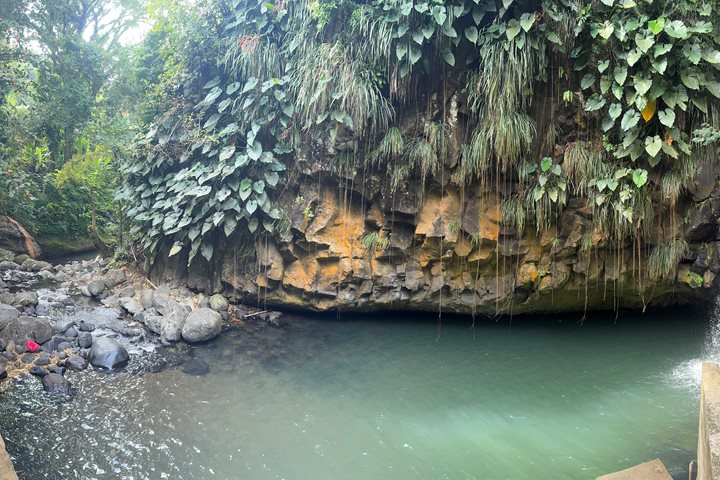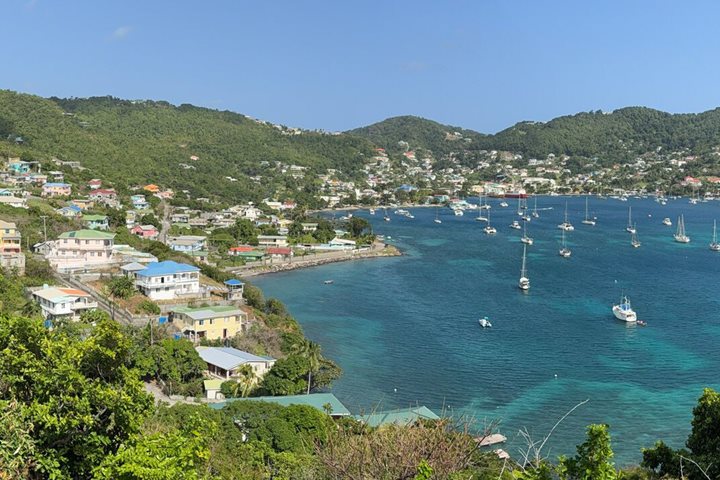We sailed abreast of Prince Rupert Bay at 7 a.m. and turned east to anchor in the bay. I have been longing to get back to Dominica since Hurricane Maria struck, but I was not prepared for what I saw. The massive pier where we traditionally docked was gone, blown away. Where I expected to see old familiar palms gently blowing in the morning breeze, now there were broken trees and split limbs. Dominica suffered a Category 5 hurricane; the most severe tracked in this area, with winds reaching 180 miles per hour. The storm struck at night and our guides said the winds were as loud as the roaring of airplane engines.
After an early breakfast we took the tenders into a new pier and boarded our minivans for our trip up to the top of Morne Diablotins, the highest point on the island at 4,770 feet. Our guides were so pleased to see us; delighted. Most tour operators have avoided Dominica since the hurricane. Lindblad to its great credit, wished to continue to support the island when it needed it most.
Our trip to the rain forest was remarkable. As we climbed ever higher into the low-hanging clouds, we could see swaths of forest stripped of all foliage. But we were intrepid and continued. The trail through the rain forest was rugged, and there was a massive gum tree, five feet in diameter, blocking the trail, and we had to climb over it. Truly an expedition! We were rewarded with a sighting of the shy and endangered sisserou parrots. We also saw the shy zandoli lizard on our track through the rain forest. The names of the trees in the rain forest are given in both their botanical name and in the local patois. The Kriol names are an education in and of themselves. Here is one of my favorites: the “Bwa Kaka” tree, whose wood is used for shingles. The Kriol spelling of the French “bois” for wood is “bwa,” and the word “kaka” (needing no further explanation) describes the rather noxious smell of the tree when it is cut. On our return to the ship a number of us were dropped off in Portsmouth and walked through the wonderful Saturday farmer’s market. We bought homegrown coffee and cinnamon, talked to the locals about “Bwa Bande” (a local herbal Viagra), and learned how a teaspoon of coconut oil a day will help you live to 100. There was a festive reggae band playing on the pier--–a living testament to the indomitable spirit of Dominicans. A fabulous morning!
After a lunch of freshly caught red snapper, we visited the 18th-century British Fort Shirley. I gave a brief overview of Cabrits Point and of Fort Shirley in the open air under the canopy of the great mango tree. This great sentinel still stands though battered. The fort was begun in 1774 and largely completed by 1778 and was built entirely by local slave labor. The fort is massive and spreads across most of the 200 acres of the Cabrits’ headland. It has only been possible to recover a small part of the original. Strangler vines and jungle cover the rest of the compound. The fort never saw action and existed principally as a deterrent against the French. It was designed by the 18th-century American architect Peter Harrison to protect the Royal Navy at anchor in Prince Rupert Bay. The fort’s canons could sweep the entire area in front of the town of Portsmouth. There was another battery across the Bay. Combined, the two batteries made the bay inviolable. The fort had 700 enlisted men and a contingent of the 8th West Indian Regiment made up of slaves. This latter regiment rose up in rebellion against the harsh treatment they received at the hands of Colonial Governor Andrew Cochrane-Johnstone in 1802. The Fort was abandoned in 1852-54 and lay derelict and in ruin, covered by a mass of strangler figs and the jungle. A good friend of mine, Dr. Lennox Honychurch, a native of Dominica, undertook restoration beginning in 1982 and is still at work. I think we would all agree that he has accomplished miracles.
After our visit to the fort we were hot and nothing sounded better than a dip in the sea. The minivans dropped us at the lovely, sandy Purple Turtle beach where we spent a luxurious hour in the sea. Later we said our farewell to Portsmouth and sailed out of Prince Rupert Bat at 6 p.m. toward Ile des Saintes.
We had dinner al fresco, floating aboard one of the historic great ships in a tropical sea surrounded by coconut palms, enjoying rum punches, champagne, and exquisitely prepared food! It is no wonder the citizens of Dominica call this island paradise.







